Sentence Types And Functions - San Jose State University
San José State University Writing Centerwww.sjsu.edu/writingcenterWritten by Sarah AndersenSentence Types and FunctionsChoosing what types of sentences to use in an essay can be challenging for several reasons. Thewriter must consider the following questions: Are my ideas simple or complex? Do my ideasrequire shorter statements or longer explanations? How do I express my ideas clearly? Thishandout discusses the basic components of a sentence, the different types of sentences, andvarious functions of each type of sentence.What Is a Sentence? A sentence is a complete set of words that conveys meaning. A sentence can communicateo a statement (I am studying.)o a command (Go away.)o an exclamation (I’m so excited!)o a question (What time is it?)A sentence is composed of one or more clauses. A clause contains a subject and verb.Independent and Dependent Clauses There are two types of clauses: independent clauses and dependent clauses. A sentencecontains at least one independent clause and may contain one or more dependent clauses.An independent clause (or main clause)o is a complete thought.o can stand by itself.A dependent clause (or subordinate clause)o is an incomplete thought.o cannot stand by itself.You can spot a dependent clause by identifying the subordinating conjunction. A subordinatingconjunction creates a dependent clause that relies on the rest of the sentence for meaning. Thefollowing list provides some examples of subordinating conjunctions. although because even though since when until whereasIndependent and Dependent ClausesafterasbeforeifthoughwhileunlessIndependent clause:Dependent clause:When I go to the movies, I usually buy popcorn.When I go to the movies, I usually buy popcorn.Independent clause:Dependent clause:I don’t like the ocean because sharks scare me.I don’t like the ocean because sharks scare me.Sentence Types and Functions, Spring 2014.1 of 6
What Are the Different Types of Sentences?Sentences are divided into four categories: simple sentences, compound sentences, complexsentences, and compound-complex sentences.Simple SentencesDefinitionExamplesA simple sentence contains one independent clause. Johnny rode his bike to school.Who is your best friend?She ate her lunch, took a walk, and went back to work.Compound SentencesDefinitionA compound sentence contains two independent clauses. A coordinatingconjunction (for, and, nor, but, or, yet, so) often links the twoindependent clauses and is preceded by a comma.Examples She wanted to go on vacation, so she saved up her money.I like apples, but my sister loves bananas.Tim loves to read, and he also loves to hike.Complex SentencesDefinitionA complex sentence contains one independent clause and one or moredependent clauses. A complex sentence will include at least onesubordinating conjunction.Examples She went to class even though she was sick.As John was arriving to work, he realized he forgot his lunch.While I enjoy classical music, I prefer rock and roll because I playthe drums.Compound-Complex SentencesDefinition A compound-complex sentence combines complex sentence andcompound sentence forms. A compound-complex sentence containsone or more independent clauses and one or more dependent clauses.Examples Although she felt guilty for missing her friend’s birthday, she tookher out to dinner the next day, and they had a great time.I try to eat healthy food, but because fast food is so convenient, Icannot maintain a healthy diet.If he got the job, he would have to commute 50 miles to work, so hedecided the job was not worth it. Sentence Types and Functions, Spring 2014.2 of 6
What Are the Functional Purposes of each Type of Sentence?Because each type of sentence can serve various functions, the writer should use the type ofsentence that best communicates the purpose of his or her idea. Choose the sentence type that will most clearly and accurately convey the logic of your idea.Consider the amount of information your readers need, and consider the links the readersneed to process the information.Vary sentence structures to pace your readers through your argument.Functions of Simple SentencesUse simple sentences when presenting a limited amount of information. Although simplesentences may be shorter, they are not any less academic than other sentence types.To declare a directstatementTo display a simplelistTo give concisedirectionsTo ask a question First, I will give background information about my project.This conclusion is supported by extensive evidence.The researchers created their hypothesis, conducted some tests, anddrew their conclusions.My evidence comes from journal articles, periodicals, and books.Please consider my application for the internship.Turn to Table 1 in the appendix.What is the true meaning of the poem?What will this study mean to medical research in a decade?Functions of Compound, Complex, and Compound-Complex SentencesCompound, complex, and compound-complex sentences can serve similar purposes. The writercan tailor the amount of information he or she provides by adding independent and dependentclauses to simple sentences.To combine similarideas To compare orcontrast ideas To convey cause andeffect or chain ofevents Compound: Recycling is an effective way of helping theenvironment, and everyone should recycle at home.Complex: Since recycling is an effective way of helping theenvironment, everyone should recycle at home.Compound-Complex: Since recycling is an effective way of helpingthe environment, everyone should recycle at home; we can all worktogether to protect our planet.Compound: Van Gogh was a talented and successful artist, but hehad intense personal issues.Complex: Although he was a talented and successful artist, VanGogh had intense personal issues.Compound-Complex: Although he was a talented and successfulartist, Van Gogh had intense personal issues; indeed, many say hisinner turmoil contributed to his beautiful art.Compound: The researchers did not come to the correct conclusion,so they restructured their hypothesis.Sentence Types and Functions, Spring 2014.3 of 6
To elaborate on aclaim or extendreasoning Complex: Since the researchers did not come to the correctconclusion, they restructured their hypothesis.Compound-Complex: Since the researchers did not come to thecorrect conclusion, they restructured their hypothesis, and they willattempt the experiment again.Compound: Cell phones should not be permitted in class, for theydistract students and teachers.Complex: Since cell phones distract students and teachers, theyshould not be used in class.Compound-Complex: Since cell phones distract students andteachers, they should not be used in class, and I encourage faculty toforbid their use.Activity 1Directions: Identify the sentence type. Circle any coordinating or subordinating conjunctions.Underline independent clauses once and dependent clauses twice. Then, explain what functionthe sentence is performing.1. Harry Potter was rejected from many publishers before J.K. Rowling found success.Sentence type:Function:2. Even though the patients showed various symptoms, the clinical study found that lack of sleepcontributes to the inability to focus, irritability, and poorer health.Sentence type:Function:3. More and more students are relying on online databases to find sources.Sentence type:Function:4. The business analysts proposed higher numbers for next quarter, and they expect to exceedthose numbers the following quarter.Sentence type:Function:Sentence Types and Functions, Spring 2014.4 of 6
5. Homeless teens face intense obstacles, but when it comes to schooling, they do have thechance to receive an education if they enroll in a special program.Sentence type:Function:Activity 2Directions: Practice composing your own sentences given the information provided. Considerwhat sentence type will be best to express the information.1. You are telling the reader about three important qualities of a character in a book.Sentence:2. You are showing both sides of an argument.Sentence:3. You are wondering about the types of resources available to students at SJSU.Sentence:4. You are describing a sequence of events.Sentence:5. You are providing extensive detail about a particular event.Sentence:Sentence Types and Functions, Spring 2014.5 of 6
Answer Key for Activity 11. Complex; convey a chain of events2. Complex; compare/contrast ideas3. Simple; declare a simple statement4. Compound; combine similar ideas5. Compound-complex; elaborate on a claim, cause/effectAnswer Key for Activity 2Since answers will vary, bring your sentences from this activity to the Writing Center so you canreview them with a tutor.Sentence Types and Functions, Spring 2014.6 of 6
handout discusses the basic components of a sentence, the different types of sentences, and various functions of each type of sentence. What Is a Sentence? A sentence is a complete set of words that conveys meaning. A sentence can communicate o a statement (I am studying.) o a command (Go away.) o an exclamation (I’m so excited!)
A. Compound sentence B. Complex sentence C. Simple sentence D. Compound complex sentence 13. The students left the classroom although their teacher told them not to. A. Simple sentence B. Compound complex sentence C. Compound sentence D. Complex sentence 14. Five of the children in my
The sentence Sentence types Sentence functions Other sentence types Special and minor sentence types Structure and style Index of tables Introduction This web page is intended for students who are following GCE Advanced level (AS and A2) specifications in English Language.
Sentence Diagramming The Sentence Diagram A sentence diagram is a picture of how the parts of a sentence fit together. It shows how the words in the sentence are related. Subjects and Verbs To diagram a sentence, first find the simple subject and the verb (simp
Sentence structure is the grammatical arrangement of words in a sentence . Each structure results in a different type of sentence . Read the chart below . Sentence Type Definition Example simple a sentence consisting of one independent clause, or a clause that can stand on its own as a sentence Talia is a great soccer player . compound a .
-Simple Sentence-Compound Sentence-Complex Sentence. The Simple Sentence A simple sentence has one independent clause(one subject and a verb): I live in San Francisco. Subject Verb. Compound Sentence A compound sentencecontains two . syntax varied sentences powerpoint Created Date:
A sentence is a word group that contains a subject and a verb and that expresses a complete thought. A sentence fragmentis a word group that looks like a sentence but does not contain both a subject and a verb or does not express a complete thought. SENTENCE FRAGMENT Those on board the sail
Unit 1 - "The Simple Sentence" b Unit 3 - "Building Better Sentences" c. Unit 4 - "Understanding the Sentence Unit" 2. Filmstrips: From files C18.12 and 803.08. a. Kinds of Sentences" b. "Parts of the Sentence or Clause" c. "Verb and the Sentence" d. "Recognizing Phrases" e. "Sentence Structure: Basic Principles" f. "Sentence Structure: Simple .
2 Current UK Coronavirus (COVID-19) situation and advice What is the current UK situation regarding Coronavirus? The current coronavirus alert level in the UK is 4, which means Covid-19 is in general circulation, transmission is high or rising and current social distancing measures and restrictions are in place. From 5 January 2021 the Government imposed a national lockdown. This means .






















